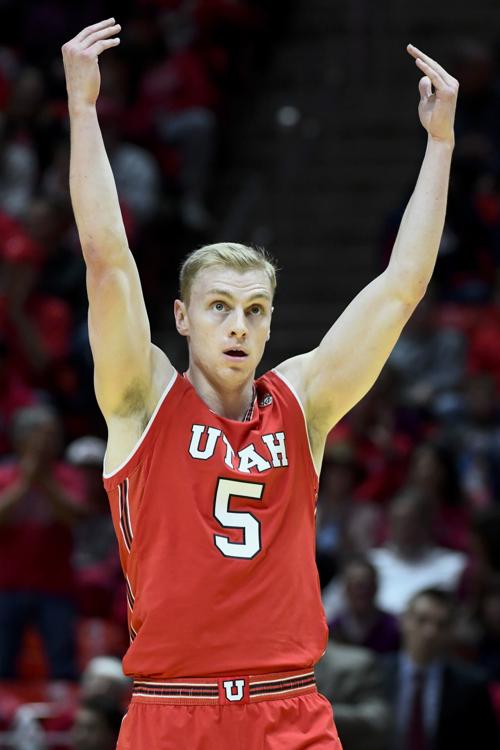SALT LAKE CITY — Do you realize that after swishing five consecutive 3-pointers in the first half Thursday night, Utah’s Parker Van Dyke didn’t start the second half?
The Utes aren’t that deep — they aren’t a powerhouse, either, ranked No. 108 in the KenPom.com analytics — but Arizona had nobody to guard PVD, sort of like the way it had no one to guard Wisconsin’s Sam Dekker in the 2015 Elite Eight.
Dekker went 5 for 6 from 3-point distance in that still-bitter loss to Wisconsin, but PVD went a bit beyond that on Thursday, burying seven of his first eighth shots from long range.
UA coach Sean Miler was so perplexed that he emptied the bench and his playbook with seven minutes remaining, inserting end-of-the-bench guys Jake DesJardins and Matt Weyand, and ordered his team to play a rare zone defense.
It didn’t work, either. The Utes won 83-76.
Van Dyke, who is averaging 7.1 points per game, scored 23. That’s like a weekend golfer who can’t break 90 suddenly shooting a 72.
This is what happens on a six-game losing streak. Subs like Parker Van Dyke do their best imitation of Jimmer Fredette, or Sam Dekker.
A week ago, Van Dyke hit a buzzer-beating 3-pointer to beat UCLA, and he had a twinkle in his eye Thursday, saying “a little magic came home with me from Westwood.”
You may be wondering where you’ve heard the name Parker Van Dyke before. How old is he anyway? He committed to play basketball at Utah just before Christmas in 2012, when Arizona was breaking in the nation’s No. 3 recruiting class.
Yes, it’s been a long time, but you probably remember Brandon Ashley, Kaleb Tarczewski, Grant Jerrett, Gabe York and Angelo Chol, all ranked among the nation’s top 60 prospects.
As it turns out, PVD had more staying power than any of Arizona’s gems of the Class of 2013. It is a direct rebuttal to Arizona’s one-and-done system.
Van Dyke chose between Utah, Arizona State and Utah State. It was no surprise when he chose the Utes: Van Dyke grew up about two miles from campus at East High School, a Ute for life.
After Jerrett, Chol and Ashley left Arizona, Van Dyke returned to the Utes after serving a two-year Mormon mission in Alabama.
“It feels like I had two freshman years here,” he said.
PVD turns 25 this year. He’s not your typical shooter. His hair is thinning, he could use some time in the weight room, he’s not a dynamic dunker or anything to remind you of Steph Curry.
But he’s probably the best pure shooter in the Pac-12, or close to Washington State’s Robert Franks. He is what Arizona lacks — a go-to shooter.
“Everybody in the league now knows not to let him catch and shoot,” said Utah coach Larry Krystkowiak.
At game’s end, Krystkowiak and Miller shook hands and chatted. Miller smiled and laughed a bit. That’s not his normal routine after a losing game, but this isn’t a normal season.
Krystkowiak said he can sympathize with Miller; struggling is a shared feeling among coaches. Krystkowiak had gone 1-13 against Arizona until Thursday.
“It’s not always going to be rosy,” said Krystkowiak. “This isn’t always a fun business to be in. It gets hard when you get beat up. This is a survival for all of us.”
Utah went 6-25 in Krystkowiak’s first season, 2011-12, and lost nine consecutive games. Since then, the Utes have become one of the Pac-12’s toughest outs. Utah can’t match the basketball history and tradition of UCLA and Arizona, but they are a strong No. 3 in the league.
MORE: Arizona Wildcats can't stop Utah's shooting star in sixth straight loss
Before the game, he talked briefly with Miller about the state of the Pac-12, which is about as jumbled and difficult to project as is possible.
“When I talked to Sean, we agreed that we’re all trying to find a bye into the Pac-12 Tournament,” Krystkowiak said.
Arizona’s chances for one of the four byes has faded significantly. Sunday’s game at Colorado is surely as imposing as any on the remaining schedule, and if the Wildcats lose at the Coors Events Center they will be 5-8 in the conference with seven consecutive losses.
That’s not a bye-type scenario.
It’s not that Arizona hasn’t gone 0-6 before. It went 0-16 in 1958-59, a season so bleak that the Wildcats lost 115-62 to Air Force. And it went 0-15 in 1982-83, which was probably worse because it included 14 consecutive Pac-10 losses.
This UA team has considerably more talent than the ’59 and ’83 teams, but one thing it can’t duck is that it is shooting 42.4 percent, which is the lowest at Arizona since 1972.
Judging from Krystkowiak’s comments, Arizona shouldn’t expect to get anything but the best shot of its final six opponents.
He twice referred to Thursday’s game as a “heavyweight fight.”
Arizona isn’t in the heavyweight division this year — no one in the Pac-12 is — but the fact that the Utes all but made it a “statement game” suggests the Wildcats continue to have a target on their chest.
“This is my first victory over Arizona as a Ute,” said Van Dyke, which is similar to what Washington State’s players, previously 0-13 against Arizona, said after beating the Wildcats last week.
By March, that might be an echo through the league.





